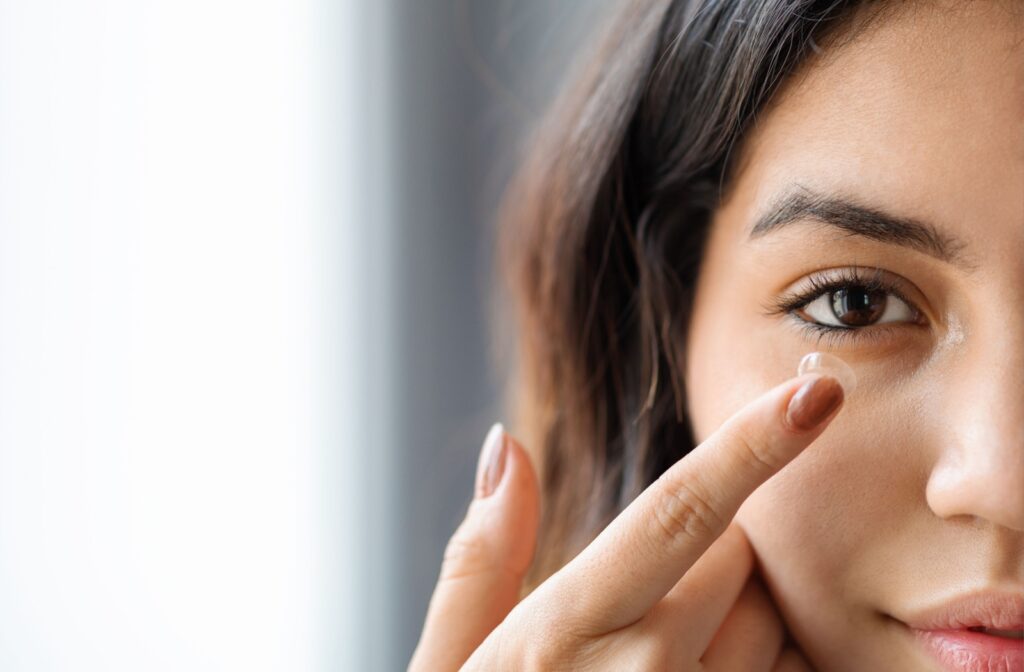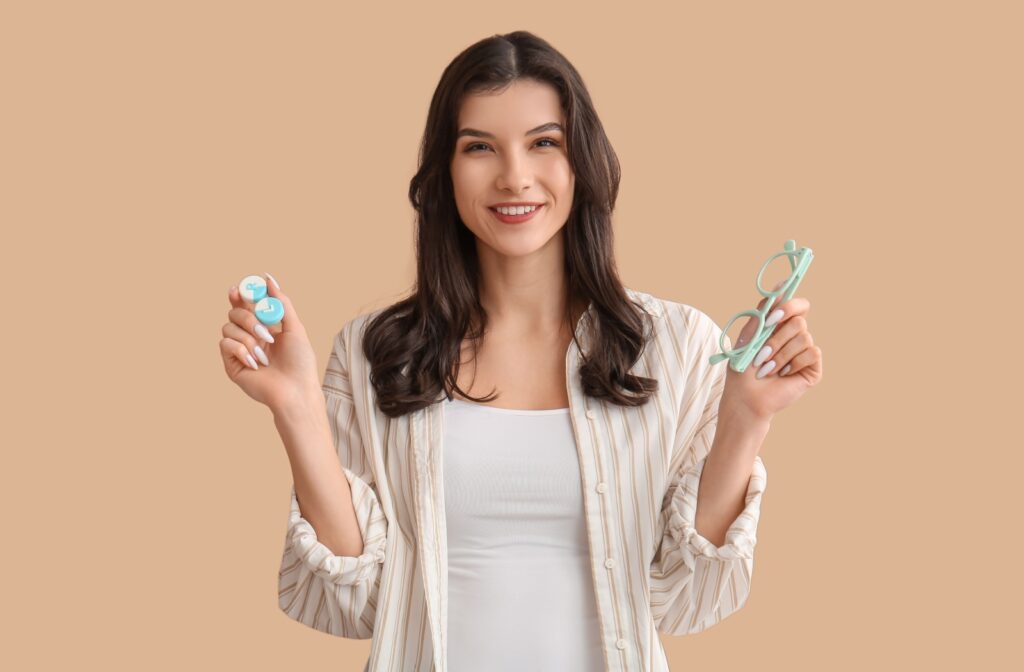When you’re running low on your contact lens supply or your glasses need an update, you know who to turn to: your optometrist. But just because your eye doctor can dispense both glasses and contact lenses doesn’t mean these devices share the same prescription.
If you take a closer look, you might be surprised to see that the numbers differ slightly, which is perfectly normal. Glasses and contact lenses need different prescriptions because they sit at different distances from the eyes.
Finding comfortable contact lenses isn’t as easy as swapping your glasses prescription for contacts. Rather, it’s as simple as booking a contact lens fitting with your optometrist.
Contact Lens vs Glasses Prescriptions
If you wear glasses and are considering making the switch to contact lenses, you might assume your current prescriptions will work perfectly for contacts, too. After all, both correct your vision, right? It’s a good guess, but the reality is a little different.
Contact lens prescriptions and glasses prescriptions are not the same, and here’s why:
Distance from Your Eyes Matters
The primary reason for this difference is how each corrective lens interacts with your eye.
Glasses sit a few millimetres away from your eye, resting on the bridge of your nose, meaning there’s a significant amount of space between your eye and the lens.
Alternatively, contact lenses sit directly on the eye’s corneal surface, eliminating this gap entirely. Naturally, this means your optometrist will adjust the strength of your prescription accordingly.
Your Eye’s Unique Shape
Since contacts are constantly touching your eye, we have to make sure they fit comfortably while also seamlessly correcting your vision. Every eye is different, so contact lenses must conform to your eye’s specific curvature.
During your contact lens fitting, your optometrist measures several aspects of your eye’s shape, including:
- Corneal curvature: How steep or flat your cornea is
- Eye diameter: The size of your iris and pupil
- Tear film quality: How well your eyes produce and maintain moisture
Contact lenses should fit snugly and feel so comfortable and natural that you may not even remember you’re wearing them. These measurements help determine which lens material, size, and curvature fit your eyes perfectly.
Additional Prescription Components
While glasses prescriptions typically include sphere (nearsightedness or farsightedness), cylinder (astigmatism), and axis measurements, more parameters go into a contact lens prescription, including:
- Base curve: The curvature of the contact lens’s back surface
- Diameter: The width of the contact lens
- Brand and material: Specific lens recommendations based on your eyes’ needs

What Happens During a Contact Lens Fitting?
A contact lens fitting is what follows your contact lens exam, during which your optometrist measures your eyes to find the right contact lens prescription and lens type that aligns with your needs. Put simply, a contact lens exam is like a standard routine eye exam but with a few extra steps.
Even if you’re a seasoned pro with your contacts, an annual lens fitting is for everyone. Your eyes can change over time, and your contact lens needs may change too. Annual fittings verify we’re fitting you in lenses that align with your visual needs, eye health, and lifestyle.
Here’s what you can expect during your contact lens fitting:
The Eye Exam
A proper contact lens fitting begins with a comprehensive eye examination. Your optometrist will evaluate your overall eye health, measure your prescription, and assess whether you’re a good candidate for contact lenses.
We’ll discuss your lifestyle, work environment, and personal preferences. Are you looking for daily disposables or monthly lenses? Do you spend long hours at a computer, or are you more active outdoors? Alternatively, some people do better with silicone hydrogel materials, while others prefer traditional hydrogel lenses.
These factors influence which type of contact lens is right for you.
Precise Measurements
Because contact lenses rest directly on your eyes, your optometrist will take a few extra measurements to ensure a precise and comfortable fit:
- Keratometry measures the curvature of your cornea’s front surface. This reading helps determine the appropriate base curve for your contact lenses.
- Pupil and iris diameter measurements verify that the contact lens will cover the appropriate area of your eye and provide clear vision.
- Tear film assessment evaluates your eye’s natural moisture production. Some people have naturally drier eyes and may need specific lens materials or additional hydrating drops.
Trial Period
Unlike glasses, which can be made precisely to your prescription, contact lenses often require a trial period. Your optometrist will provide trial lenses based on your measurements and have you wear them for several days to assess comfort and vision quality.
During this trial period, you’ll learn proper insertion, removal, and care techniques. You’ll also discover how the lenses feel during different activities and throughout the day.
If you and your optometrist are happy with the trial contacts, they will finalize your prescription. From here, you can place an order for your supply!
Taking the Next Step
Contact lenses are popular for a reason! With the right fit and prescription (thanks to a lens fitting), contacts feel comfortable and seamless, offering freedom from glasses. Whether you prefer wearing them daily or on special occasions, there may be a contact lens that perfectly aligns with your visual needs and lifestyle.
Don’t let uncertainty about prescription differences prevent you from exploring your contact lens options. A professional contact lens exam and fitting is all it takes. Connect with our Lake Country Optometry team to book your appointment today!




